Physical Address
304 North Cardinal St.
Dorchester Center, MA 02124
Physical Address
304 North Cardinal St.
Dorchester Center, MA 02124
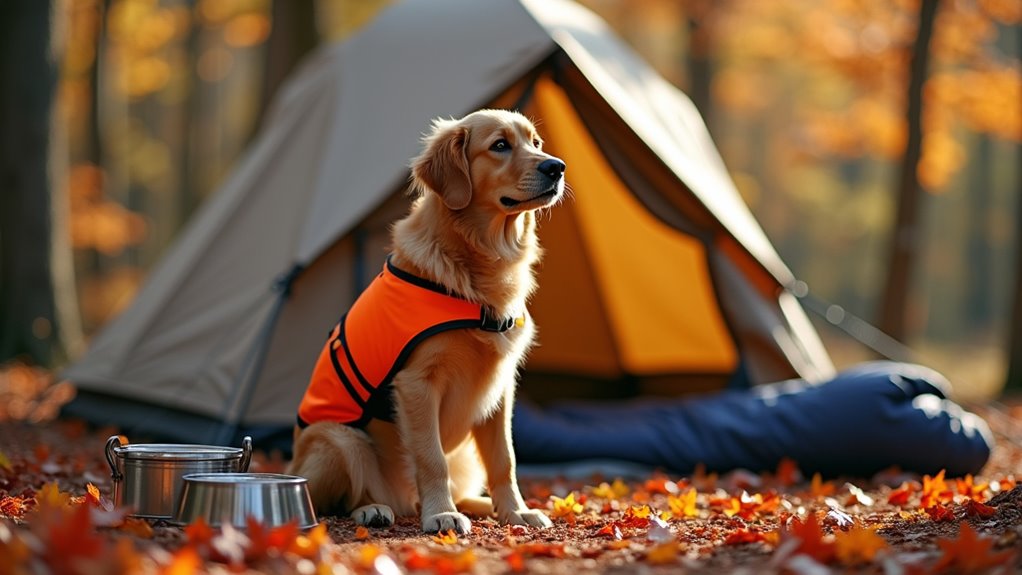
Navigate fall camping's hidden dangers and surprising nutritional demands that could put your dog at serious risk this season.
Did you know that your dog’s caloric needs can increase by up to 25% during fall camping trips due to the energy required to maintain body temperature in cooler weather? While you’re busy planning your gear and route, your furry companion faces unique seasonal challenges that go far beyond just staying warm. From toxic fallen leaves that weren’t dangerous in summer to wildlife behavior changes that affect trail safety, fall camping with dogs demands a completely different approach than you’d expect.
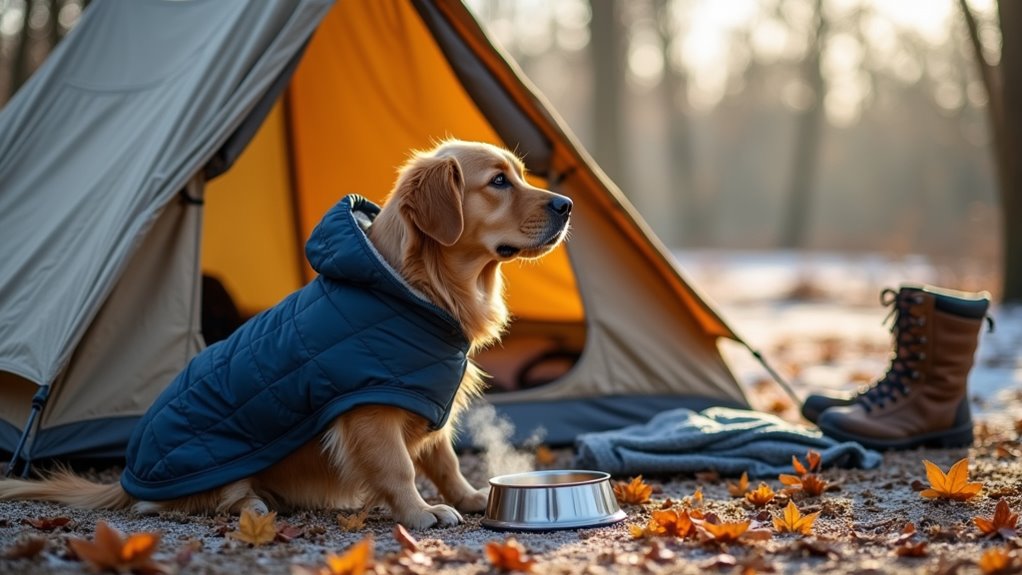
When temperatures drop and daylight hours shrink, your dog’s camping gear needs become just as critical as your own. You’ll need an insulated dog sleeping pad to protect them from cold ground that saps body heat.
Pack a waterproof dog jacket for breeds with thin coats or short fur. Bring booties to shield paws from sharp rocks, ice, and snow that can cause cuts or frostbite.
Protect vulnerable breeds with waterproof jackets and sturdy booties to prevent cold-weather injuries from harsh terrain and freezing conditions.
Don’t forget reflective gear like LED collars or light-up leashes since darkness falls earlier. A portable dog blanket provides extra warmth inside your tent.
Pack their regular food plus high-calorie treats—dogs burn more energy staying warm. Finally, include a basic first-aid kit with paw balm and emergency contact information for nearby veterinarians.
Beyond keeping your dog warm and comfortable, you’ll need to stay alert for wildlife that becomes more active during fall months. Bears are preparing for hibernation and aggressively foraging for food. Meanwhile, territorial animals like elk and deer become more unpredictable during mating season.
Keep your dog leashed at all times and maintain close supervision around campsites. Store all food, treats, and scented items in bear-proof containers or hang them properly. Never let your dog chase wildlife or investigate animal tracks and scat.
If you encounter large animals, don’t run. Keep your dog close, make yourself appear larger, and back away slowly while making noise. Carry bear spray as backup protection.
Research the specific wildlife risks for your camping area beforehand and adjust your precautions accordingly. Plus, take measures to protect both you and your dog from tick bites since these parasites remain active in fall weather and can transmit diseases to both humans and pets.
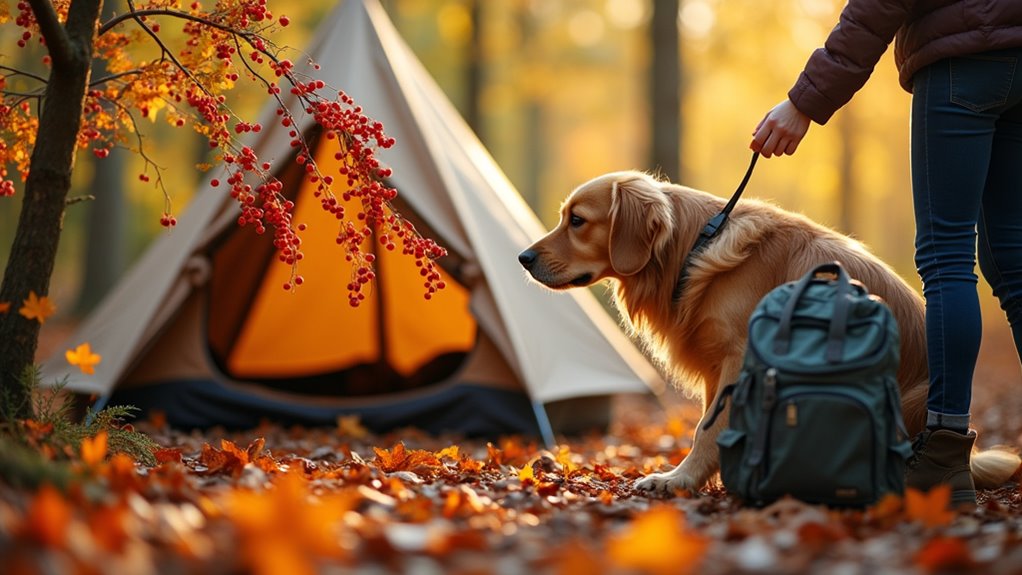
As colorful leaves carpet forest floors and hiking trails, many beautiful autumn plants pose serious threats to your dog’s health. You’ll need to identify and steer clear of several common toxic plants during fall camping trips.
Watch for mushrooms sprouting from decaying logs and leaf litter – many varieties are deadly poisonous. Keep your dog away from acorns and oak leaves, which contain tannins that cause kidney damage. Fallen walnuts develop toxic mold that triggers seizures and tremors.
Deadly mushrooms, toxic acorns, and moldy walnuts lurk beneath autumn’s beauty – keep your curious canine safe on forest adventures.
Red maple leaves turn brilliant crimson but become highly toxic when wilted. Wild cherries, mountain ash berries, and bittersweet vines also threaten curious dogs who sample everything.
Stay vigilant on trails, keep your dog leashed near unfamiliar vegetation, and immediately contact your vet if ingestion occurs. Plus, applying bug repellent to yourself and your dog can help prevent insect bites that may lead to secondary infections from scratching.
After keeping your dog safe from toxic plants during daytime adventures, you’ll face a new challenge when temperatures drop at night. Pack an insulated dog bed or sleeping pad to create a barrier between your pup and the cold ground. Bring a waterproof blanket or dog sleeping bag for extra warmth – avoid human sleeping bags that can overheat smaller dogs.
Set up your dog’s sleeping area inside your tent, away from drafts and tent walls where condensation forms. Dress short-haired breeds in a fleece jacket or sweater. Check your dog’s paws, ears, and nose periodically for signs of being too cold.
If they’re shivering, whining, or seeking constant contact, add more insulation or consider letting them share your sleeping bag. When selecting a sleeping bag for yourself, consider temperature ratings and insulation type to ensure you stay warm enough to monitor your dog’s comfort throughout the night.
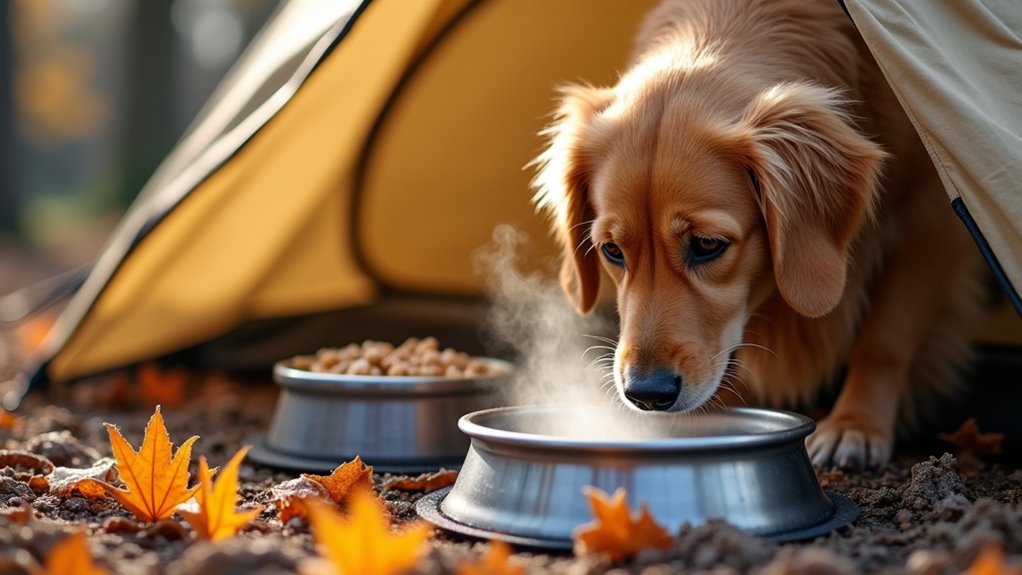
While your dog’s appetite might seem unchanged in crisp fall weather, cooler temperatures actually increase their caloric needs as their body works harder to maintain warmth. Pack 10-15% more food than usual for fall camping trips, focusing on high-quality protein and healthy fats that provide sustained energy.
Pack 10-15% extra high-protein food for fall camping as cooler temperatures increase your dog’s caloric needs for warmth.
Feed your dog smaller, more frequent meals throughout the day rather than one large portion to help maintain their energy levels and body temperature.
Water needs remain essential despite cooler weather. Dogs still lose moisture through panting and breathing, especially during hikes. Bring extra water and check that it hasn’t frozen overnight.
Warm water slightly if it’s very cold – dogs prefer drinking tepid water over ice-cold alternatives, encouraging proper hydration. While fall camping presents different challenges than summer, being prepared for hot-weather camping techniques can help you adapt your strategies for any temperature extreme your dog might encounter.
Fall terrain presents unique challenges for your dog’s paws that differ especially from summer hiking conditions. Sharp rocks, wet leaves, and thorny underbrush can cut or puncture paw pads, while cold, damp surfaces increase the risk of cracking. Before each hike, inspect your dog’s paws for existing cuts or irritation that could worsen on rough terrain.
Consider protective booties for dogs with sensitive pads or when traversing particularly rocky areas. If your dog won’t tolerate boots, apply paw balm or wax before heading out to create a protective barrier.
After each walk, clean debris from between toes and check for embedded thorns or stones. Dry wet paws thoroughly to prevent fungal infections, and apply moisturizing balm to cracked pads. Fall camping also brings increased mosquito activity in many areas, so consider using mosquito repellent strategies to protect both you and your dog from bites during your outdoor adventures.
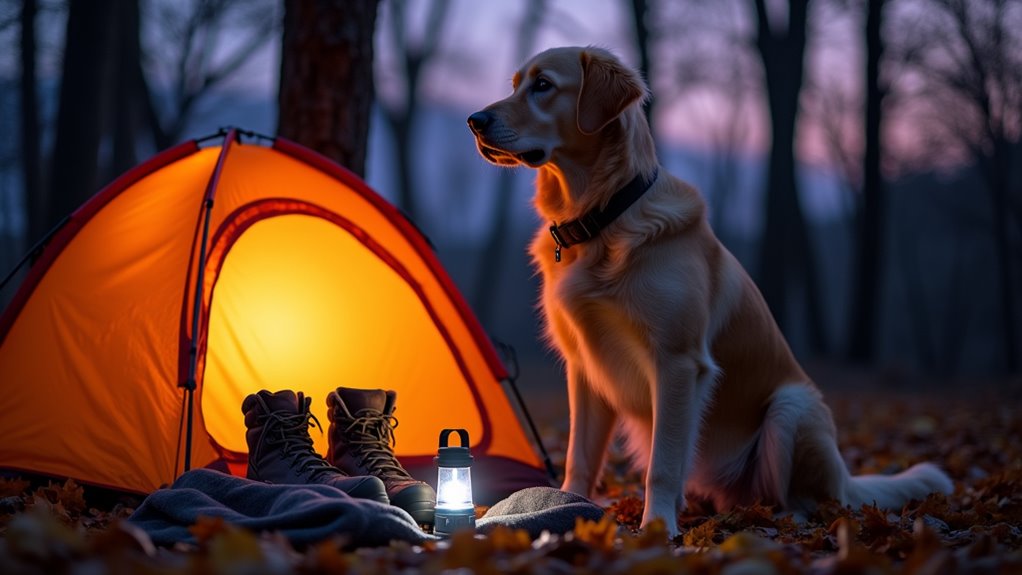
Daylight disappears faster than you’d expect during fall camping trips, often catching dog owners off guard when evening activities run longer than planned. Pack extra headlamps and flashlights for both you and your dog’s nighttime needs. Attach LED collar lights or reflective gear to keep your pup visible during evening potty breaks and walks around camp.
Plan dinner and setup tasks earlier in the day since temperatures drop markedly after sunset. Your dog’s internal clock might be confused by the earlier darkness, so maintain consistent feeding and walking schedules.
Consider shortening afternoon hikes to return before dusk. Keep your dog close to camp once darkness falls – unfamiliar terrain becomes dangerous when visibility decreases, and nocturnal wildlife activity increases considerably. If you’re planning extended hiking adventures with your dog, consider exploring established trails like Scotland’s West Highland Way, which offers well-marked paths and designated camping areas that can help ensure safer navigation even in changing light conditions.
Remote fall camping locations often lack cell service and quick access to veterinary care, making thorough emergency preparation essential for your dog’s safety. Pack a complete first aid kit including bandages, antiseptic wipes, tweezers for removing burrs or splinters, and any medications your dog takes regularly.
Bring extra food and water beyond your planned trip duration in case weather delays your return. Download offline maps and identify the nearest veterinary clinics before losing signal.
Carry a satellite communicator or personal locator beacon for true emergencies. Know basic canine first aid techniques like checking vital signs and treating minor wounds.
Share your detailed itinerary with someone reliable who’ll alert authorities if you don’t return as scheduled. When scouting potential camping spots, remember that campsite selection involves multiple critical factors that can impact both your safety and your dog’s comfort in remote wilderness areas.
You’ve planned every detail—waterproof jackets, emergency kits, paw protection—yet your dog will inevitably find the one muddy puddle you didn’t see coming. While you’re checking trail maps and monitoring wildlife, they’ll be perfectly content chasing falling leaves. You’ll worry about their warmth all night, only to wake up with them sprawled across your sleeping bag, stealing your heat. Sometimes the best-prepared adventures are the messiest ones.